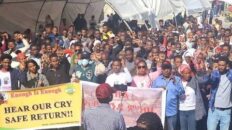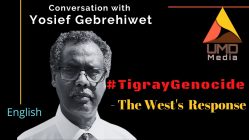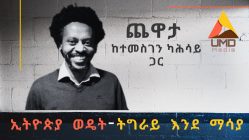Major General Teklebrhan W/Aregay (PhD)
July 30, 2024
Understanding the diverse forms of Tigrayan Nationalism is crucial for fostering meaningful dialogue, shaping a shared Tigrayan identity, and developing a unified political vision for the region’s future. This brief examines four distinct types of nationalism observed among Tigrayan elites, highlighting their differing goals while exploring potential common ground.
The brief aims to share personal observations and experiences. It seeks to initiate a constructive dialogue among concerned individuals, ultimately leading to a consolidated understanding of the issue. The focus is on providing a clear and concise description of the problem.
Varieties of Tigrayan Nationalism
A single, unifying answer to the question of Tigrayan Nationalism remains elusive. Here, we explore four prominent strands.
Strand 1: Greater Tigray (ዓባይ ትግራይ) nationalism (Irredentism)
Irredentism is a political movement aimed at reclaiming territory lost to another state, often justified by ethnic, cultural, or historical ties (Miller, 2024). It typically involves territorial claims, is rooted in ethnic or cultural identity, and has the potential to spark conflict. While concepts like those in Noel Malcolm’s Bosnia: A Short History and William Salomone’s Italy from the Risorgimento to Fascism illuminate the broader phenomenon, the specifics of Greater Tigray nationalism require further exploration. This ideology seeks to restore historical Tigrayan territories, including Eritrea and potentially parts of the Red Sea coast. The Agazian movement is a prominent example of this perspective.
Strand 2: “We vs. Them” nationalism
An ideology that promotes a strong sense of national identity and unity, often built on the exclusion of other groups deemed as outsiders or enemies. There is a vast amount of written material, research, and studies available on this topic. The ‘we vs them’ Tigrayan Nationalism is rooted in perceived historical grievances and injustice with Amhara or Ethiopia, this form advocates for Tigray’s separation. It envisions a future united with Tigrayans in Eritrea and the creation of a new Tigrayan state. The independence movement, along with many Tigrayans, advocates for this strand.
Strand 3: Benign nationalism
Benign nationalism, often characterized by patriotism, cultural pride, civic duty, and inclusivity, is generally perceived as harmless or positive. It emphasizes shared cultural values, historical heritage, and a sense of community. While patriotism reflects a love for one’s nation and its prosperity, and cultural pride appreciates traditions, arts, and language, civic duty underscores a responsibility to society, and inclusivity welcomes diversity. However, such nationalism can evolve into a more assertive form, aiming to revive a nation’s past glory. In the Tigrayan context, this involves drawing inspiration from the ancient Axumite civilization. By merging Axumite principles with 21st-century progress, it seeks to reconstitute Tigray as a nation-state and reassert its global standing. The emerging social movements (ምንቅስቓስ ንትንሳኤ ኣክሱማዊ ስልጣነ) aiming to rebirth the Axumite civilization are a prominent example in this case.
Strand 4: Instrumental nationalism
Instrumental nationalism is a concept that posits that nationalism is not primarily driven by a deep-rooted, organic sense of belonging to a nation, but rather is a tool or instrument used to achieve specific political, economic, or social goals. In essence, it suggests that nationalism is a strategic construct rather than an intrinsic identity. The concept of instrumental nationalism has been extensively explored by scholars such as Ernest Gellner (2008), Benedict Anderson (2010), and Anthony D. Smith (2016).
Instrumental nationalism is characterized by its goal-oriented nature, often employed as a tool for achieving specific objectives such as political dominance, economic gain, or social unity. Nationalist sentiments and symbols are frequently manipulated strategically to serve particular interests. Moreover, the expression and intensity of instrumental nationalism can fluctuate based on prevailing political, economic, and social conditions.
In the Tigrayan context, the TPLF has employed instrumental nationalism to consolidate central power within Ethiopia. This perspective, often associated with the party, prioritizes class struggle and envisions a federal system under strong leadership. While this approach proved ineffective in practice, its ideology persists among TPLF supporters.
Conclusion
While the benign nationalism perspective appears strategically more constructive, there’s potential for collaboration among the other three strands. Despite differences in approaches and principles, they share a common desire for a Tigrayan nation-state (albeit with varying visions of its scope and relationship with Ethiopia). Notably, the fourth strand views Tigray through a Leninist ideological lens and ultimately aspires for a federal republic within Ethiopia. Moving forward, these first three groups could focus on winning over the fourth and working together to achieve a Tigrayan nation-state, regardless of the specific path chosen. Open dialogue and a willingness to find common ground will be crucial in shaping Tigray’s future.
References
Anderson, B. (2016). Imagined communities : reflections on the origin and spread of nationalism (Revised ed.). Verso.
Gellner, E., & Breuilly, J. (2008). Nations and nationalism. Cornell University Press.
Malcolm, N. (1996). Bosnia : a short history (New, updated ed.). Papermac.
Miller, B. (2024). Nationalism and Conflict: How Do Variations of Nationalism Affect Variations in Domestic and International Conflict? Political Science Quarterly.
Salomone, A. W. (Arcangelo W. (1970). Italy from the Risorgimento to Fascism : an inquiry into the origins of the totalitarian state.
Smith, A. D. (2010). Nationalism : theory, ideology, history (2nd ed, rev.updated.). Polity.
Editor’s Note: The opinions expressed in the articles published on UMD Media are solely those of the individual authors and do not necessarily reflect the views or opinions of the editorial team or UMD Media as an organization. The publication of any opinion piece does not imply endorsement or agreement by UMD Media. Readers are encouraged to critically evaluate the content and form their own conclusions. Leave your comments below. Send us your thoughts and reflections to umd.media.2020 at gmail dot com.
Guidelines for contributors All contributions and comments submitted to UMD Media must adhere to the following guidelines. Respectful Language: Avoid using ethnic adjectives that generalize or portray an entire ethnic group in a negative light. Such language is harmful, divisive, and contrary to our commitment to fostering a respectful and inclusive environment. No Incitement: Content that incites hatred, violence, or discrimination against any individual or group based on ethnicity, race, religion, etc will not be tolerated. Constructive Dialogue: We encourage constructive dialogue and the sharing of diverse perspectives. However, it is essential to express opinions in a manner that respects the dignity and humanity of all individuals and groups. Moderation and Enforcement: Our editorial team reserves the right to moderate and, if necessary, remove any content that violates these guidelines. Repeat offenders may be subject to account suspension or banning. By contributing to our platform, you agree to abide by these guidelines and help us maintain a respectful and inclusive community.
Subscribe to UMD Media channel. Join UMD Media Telegram Channel: https://t.me/UMDMedia




